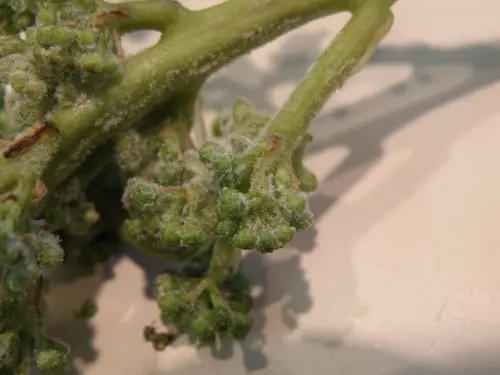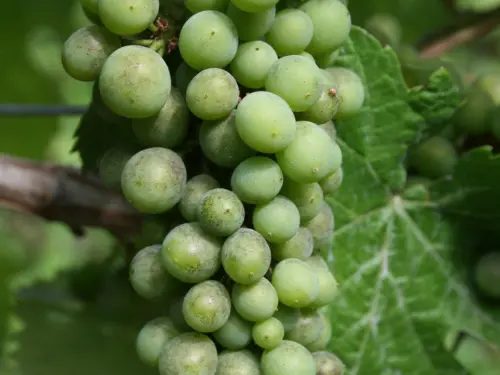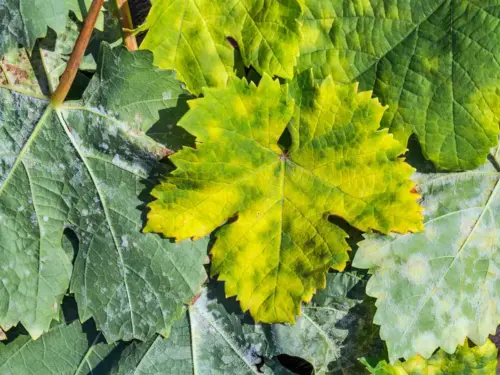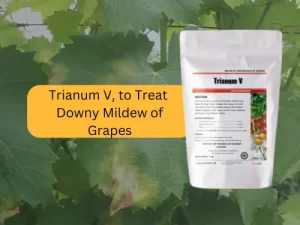The downy mildew grapes is a regular and often dangerous fungal disease which invades all vineyards in the world. Continue reading the blog to know how to treat downy mildew.

To combat downy mildew on grapes, ensure effective air circulation around the plants and apply downy mildew control fungicide like those containing copper or the biocontrol agent Trichoderma harzianum. Regular monitoring and early downy mildew organic treatment are crucial for controlling the spread of the disease.
It is attacked by the pathogenic organism Plasmopara viticola which develops well at warm and humid conditions. This disease can be as great as to yield- and quality of grapes- reducing factors and a major problem to the vineyard owners.
Realizing the symptoms of downy mildew grapes on time is a fact and a condition for the successful struggle against it. Let’s dive into details of downy mildew of grapes symptoms-
First manifestation of downy mildew would typically be formation of light green spots on the upper surfaces of the younger leaves, which can be characterised as oil spots with their greasy look. The latter discolorations first appear as light yellowish or brownish spots and worsen in time.
On the underside of the leaves, downy growth in white or grayish shade can be seen, possibly during damp or wet days. The wave of hatching spores is a confirmation of pathogens and is a definite manifestation of downy mildew.

With the progress of the disease, the yellowing and subsequent withering and the dropping of the leaves might become an issue. Leaf area loss due to defoliation can destabilize the vine integrity, and reduce its photosynthesizing capacity. This may result in a poorer vine health and lower worth of the product.
Grape bunches and berries can also be affected, showing irregular grayish or white patches. Infected berries may remain underdeveloped or become leaky and eventually drop, significantly reducing crop yield.
In severe cases, downy mildew can infect shoots and buds, causing them to turn brown and die back. This can affect the vine’s growth in the following season, as the buds are responsible for the next year’s shoots.
Managing downy mildew involves a combination of cultural practices and organic treatments. Here are some effective strategies:

Choosing the right location for a vineyard is fundamental. Sites with good air circulation and sunlight exposure help minimize the conditions favorable for downy mildew development. Sloped sites are preferable as they facilitate air movement and reduce humidity around the vine foliage.
Planting grape varieties that are resistant to downy mildew is a highly effective method to reduce disease incidence. Research the varieties best suited for your climate and soil type that exhibit resistance traits.
Proper canopy management ensures adequate air circulation and light penetration, which are critical in keeping the foliage dry and less susceptible to fungal infections. Practices include pruning, shoot thinning, and leaf removal around the grape bunches.
Frequent vineyard inspections help detect early signs of infection, allowing for timely interventions. Pay special attention during warm, humid periods, which are ideal for downy mildew growth.

Downy mildew control fungicide Trianum-V, featuring active Trichoderma harzianum powder, is the best way for downy mildew organic treatment. It effectively controls different fungi and bacteria responsible for grape downy mildew outbreaks among other harmful diseases to plants. Trichoderma harzianum acts as a mycoparasite, and it takes the place of the space of saprophytic pathogenic fungi at the same time of bringing nutrients to the plant. Besides, it is involved in the activation of the plant’s own protection mechanisms by SAR (systemic acquired resistance) and ISR (induced systemic resistance), so it may become better resistent to the disease. This is why eco-climate is a key element that caters to the requirements of grape growers who are in search of a natural way of managing soil diseases. Want to know more in details? Explore the product page on Novobac.
Investment in field and row drainage will manage the humidity at the roots and via leaf water loss. Will drainage wells be instrumental in draining your vineyard steadily if waterlogging is a usual problem?
A few strategies can be followed after harvesting. Remove and destroy all infected plant debris. Such a measure reduces the pathogen’s ability to overwinter, thus affecting their survivability and ultimately resurgence in the new season.
Enforcing the best practices of these techniques, on the other hand, can allow you to take care of your grapevines and prevent the vines from getting destroyed by downy mildew. Attending group lessons with local extension services and advance research compensation can assist as well as individualised strategies for the special kind of environment for specific regions. With careful reckoning, downy mildew can be a controllable disease, so your vineyard can enjoy sustainability and profitability.
Powdery mildew and downy mildew are two contagious fungal diseases commonly found affecting grapevines but they differ in some notable features. Powdery mildew, which is caused by Erysiphe necator, sometimes called Erysiphe graminis fungi, is a disease with a white or gray powdery coating. It can be found on leaves, shoots, and grapes. This mold prospers in warm and dry surroundings and spreads rapidly in the mean temperatures.
The oomycete Plasmopara viticola is the virus that causes downy mildew in something else. This often appears as yellow or brown spots on the leaves, with large white spots on the undersides, even in moist conditions. Unlike mildew that spreads with dry weather conditions, downy mildew needs wet conditions to grow. It can either spread through rain, or irrigation sprinklers. Both disorders can play a huge role in crop devastation but their ability to move through and visual symptoms identify them different from each other.
Know more about Powdery Mildew on Roses, powdery mildew on apple tree, cucumber powdery mildew, downy mildew on basil, downy mildew cucumber.
Food plants often get dumped by various pests and..
Fire blight apple tree is a serious bacterial disease..
Have you often spotted different types of marks on..

Leave a Reply